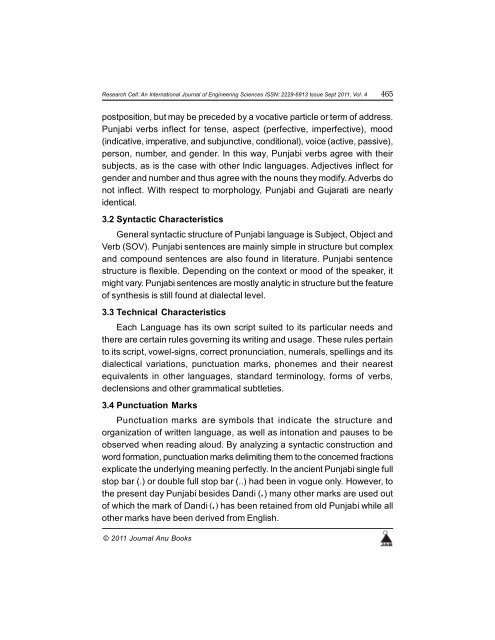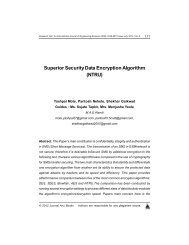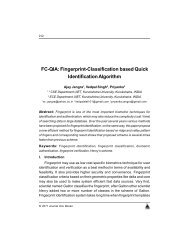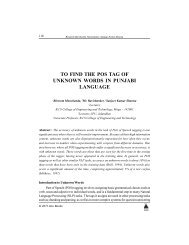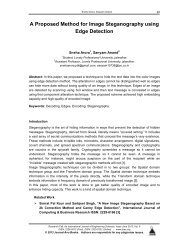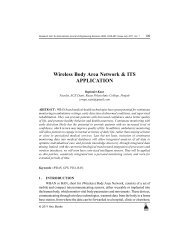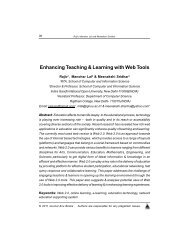An Analysis of Difficulties in Punjabi Language ... - Ijoes.org
An Analysis of Difficulties in Punjabi Language ... - Ijoes.org
An Analysis of Difficulties in Punjabi Language ... - Ijoes.org
Create successful ePaper yourself
Turn your PDF publications into a flip-book with our unique Google optimized e-Paper software.
Research Cell: <strong>An</strong> International Journal <strong>of</strong> Eng<strong>in</strong>eer<strong>in</strong>g Sciences ISSN: 2229-6913 Issue Sept 2011, Vol. 4<br />
465<br />
postposition, but may be preceded by a vocative particle or term <strong>of</strong> address.<br />
<strong>Punjabi</strong> verbs <strong>in</strong>flect for tense, aspect (perfective, imperfective), mood<br />
(<strong>in</strong>dicative, imperative, and subjunctive, conditional), voice (active, passive),<br />
person, number, and gender. In this way, <strong>Punjabi</strong> verbs agree with their<br />
subjects, as is the case with other Indic languages. Adjectives <strong>in</strong>flect for<br />
gender and number and thus agree with the nouns they modify. Adverbs do<br />
not <strong>in</strong>flect. With respect to morphology, <strong>Punjabi</strong> and Gujarati are nearly<br />
identical.<br />
3.2 Syntactic Characteristics<br />
General syntactic structure <strong>of</strong> <strong>Punjabi</strong> language is Subject, Object and<br />
Verb (SOV). <strong>Punjabi</strong> sentences are ma<strong>in</strong>ly simple <strong>in</strong> structure but complex<br />
and compound sentences are also found <strong>in</strong> literature. <strong>Punjabi</strong> sentence<br />
structure is flexible. Depend<strong>in</strong>g on the context or mood <strong>of</strong> the speaker, it<br />
might vary. <strong>Punjabi</strong> sentences are mostly analytic <strong>in</strong> structure but the feature<br />
<strong>of</strong> synthesis is still found at dialectal level.<br />
3.3 Technical Characteristics<br />
Each <strong>Language</strong> has its own script suited to its particular needs and<br />
there are certa<strong>in</strong> rules govern<strong>in</strong>g its writ<strong>in</strong>g and usage. These rules perta<strong>in</strong><br />
to its script, vowel-signs, correct pronunciation, numerals, spell<strong>in</strong>gs and its<br />
dialectical variations, punctuation marks, phonemes and their nearest<br />
equivalents <strong>in</strong> other languages, standard term<strong>in</strong>ology, forms <strong>of</strong> verbs,<br />
declensions and other grammatical subtleties.<br />
3.4 Punctuation Marks<br />
Punctuation marks are symbols that <strong>in</strong>dicate the structure and<br />
<strong>org</strong>anization <strong>of</strong> written language, as well as <strong>in</strong>tonation and pauses to be<br />
observed when read<strong>in</strong>g aloud. By analyz<strong>in</strong>g a syntactic construction and<br />
word formation, punctuation marks delimit<strong>in</strong>g them to the concerned fractions<br />
explicate the underly<strong>in</strong>g mean<strong>in</strong>g perfectly. In the ancient <strong>Punjabi</strong> s<strong>in</strong>gle full<br />
stop bar (.) or double full stop bar (..) had been <strong>in</strong> vogue only. However, to<br />
the present day <strong>Punjabi</strong> besides Dandi (.) many other marks are used out<br />
<strong>of</strong> which the mark <strong>of</strong> Dandi (.) has been reta<strong>in</strong>ed from old <strong>Punjabi</strong> while all<br />
other marks have been derived from English.<br />
© 2011 Journal <strong>An</strong>u Books


